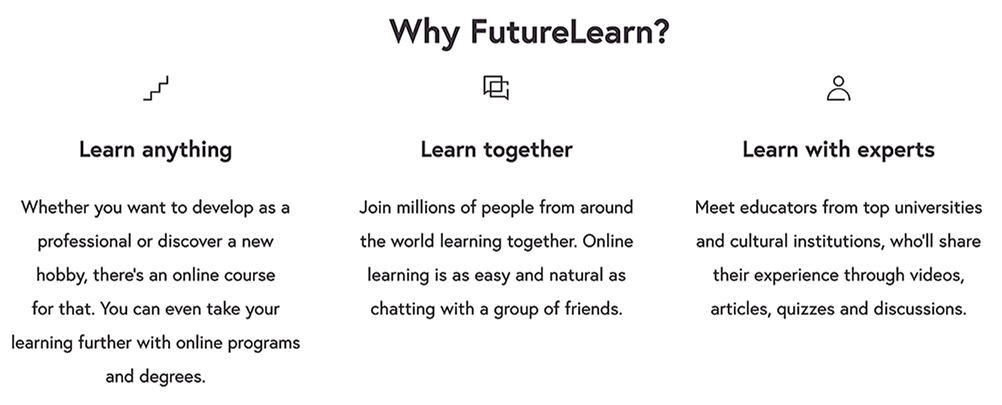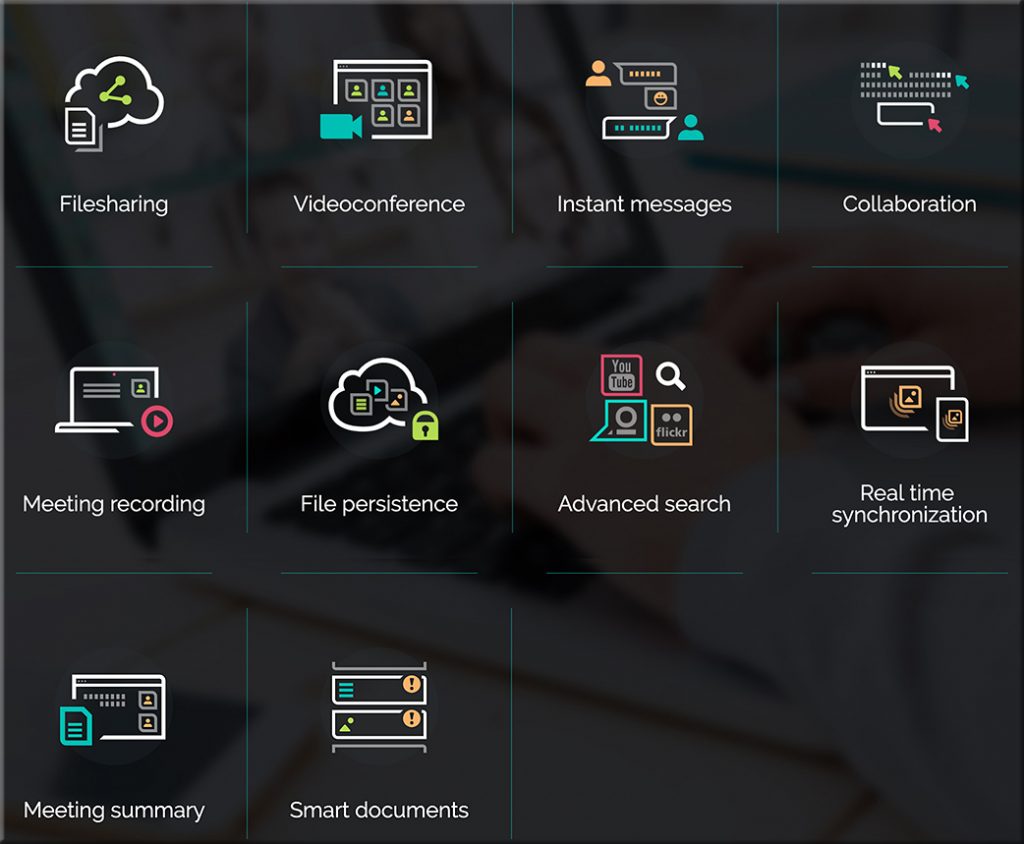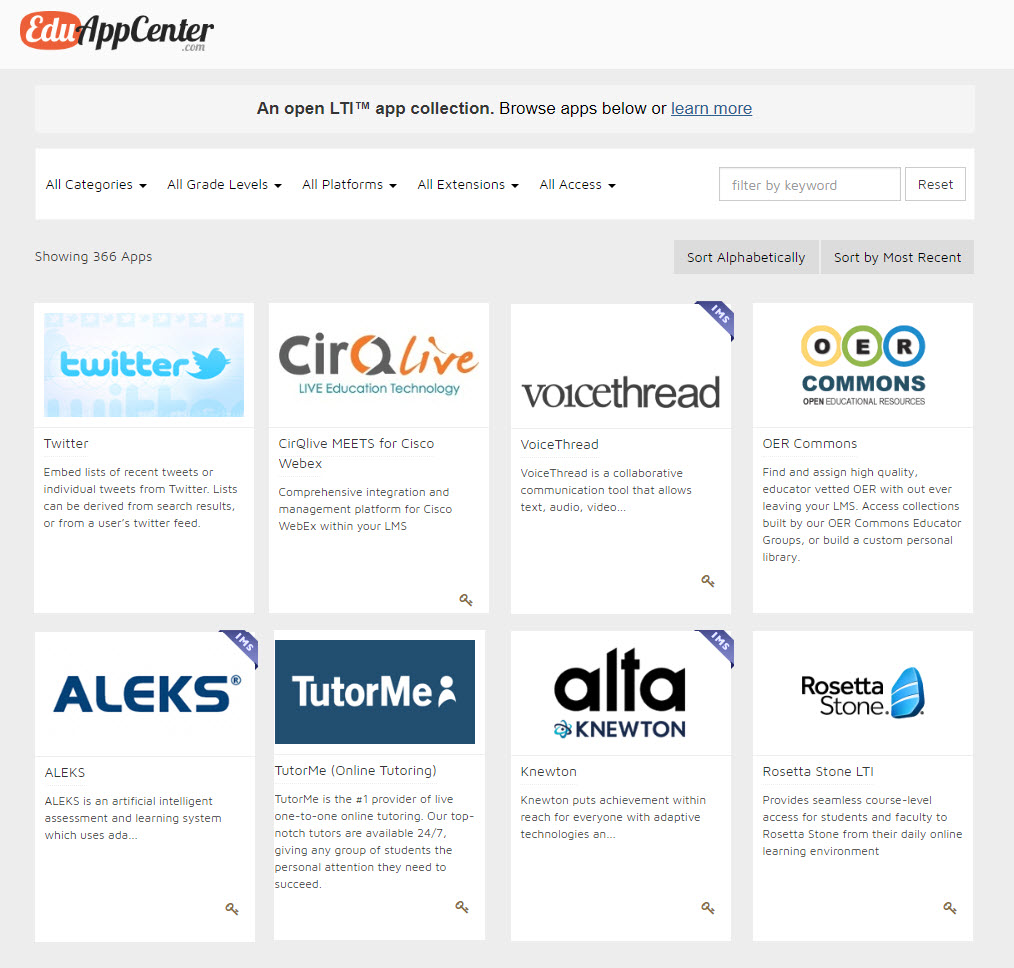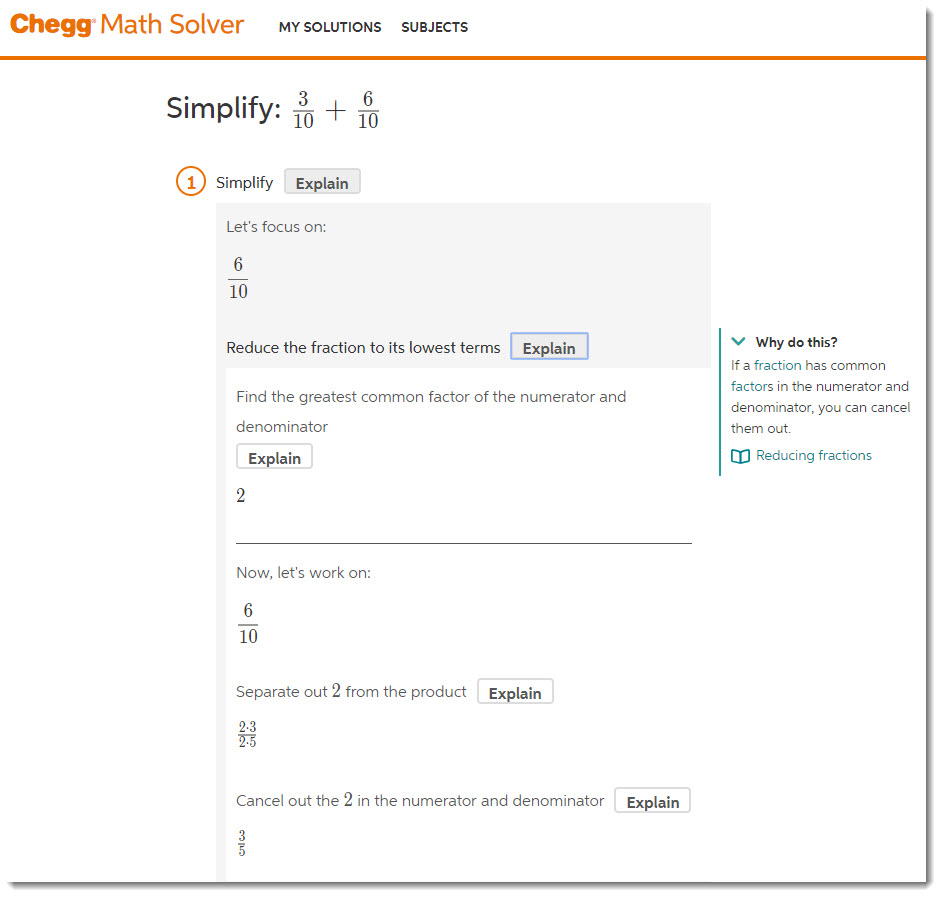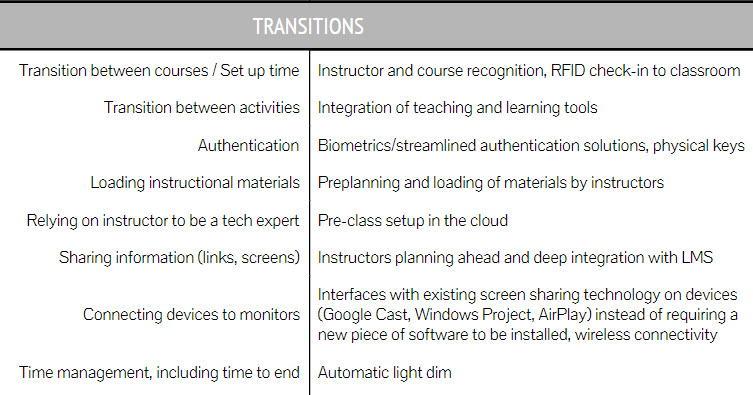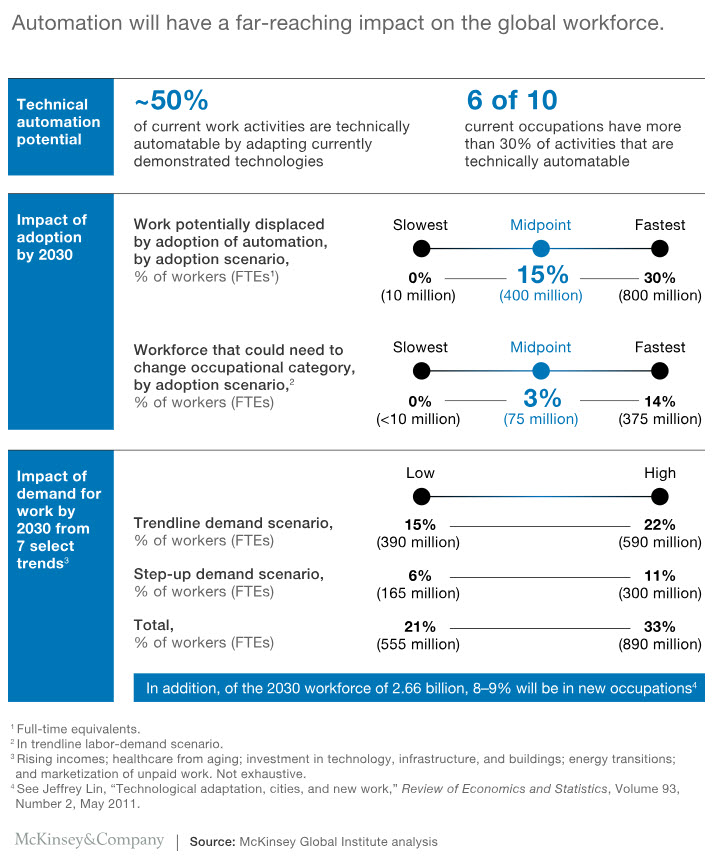
Screen Mirroring, Screencasting and Screen Sharing in Higher Education — from edtechmagazine.com by Derek Rice
Digital learning platforms let students and professors interact through shared videos and documents.
Excerpt (emphasis DSC):
Active learning, collaboration, personalization, flexibility and two-way communication are the main factors driving today’s modern classroom design.
Among the technologies being brought to bear in academic settings are those that enable screen mirroring, screencasting and screen sharing, often collectively referred to as wireless presentation solutions.
These technologies are often supported by a device and app that allow users, both students and professors, to easily share content on a larger screen in a classroom.
“The next best thing to a one-to-one conversation is to be able to share what the students create, as part of the homework or class activity, or communicate using media to provide video evidence of class activities and enhance and build out reading, writing, speaking, listening, language and other skills,” says Michael Volpe, marketing manager for IOGEAR.
Clay Shirky on Mega-Universities and Scale — from philonedtech.com by Clay Shirky
[This was a guest post by Clay Shirky that grew out of a conversation that Clay and Phil had about IPEDS enrollment data. Most of the graphs are provided by Phil.]
Excerpts:
Were half a dozen institutions to dominate the online learning landscape with no end to their expansion, or shift what Americans seek in a college degree, that would indeed be one of the greatest transformations in the history of American higher education. The available data, however, casts doubt on that idea.
Though much of the conversation around mega-universities is speculative, we already know what a mega-university actually looks like, one much larger than any university today. It looks like the University of Phoenix, or rather it looked like Phoenix at the beginning of this decade, when it had 470,000 students, the majority of whom took some or all of their classes online. Phoenix back then was six times the size of the next-largest school, Kaplan, with 78,000 students, and nearly five times the size of any university operating today.
From that high-water mark, Phoenix has lost an average of 40,000 students every year of this decade.
From DSC:
First of all, I greatly appreciate both Clay’s and Phil’s thought leadership and their respective contributions to education and learning through the years. I value their perspectives and their work. Clay and Phil offer up a great article here — one worth your time to read.
The article made me reflect on what I’ve been building upon and tracking for the last decade — a next generation ***PLATFORM*** that I believe will represent a powerful piece of a global learning ecosystem. I call this vision, “Learning from the Living [Class] Room.” Though the artificial intelligence-backed platform that I’m envisioning doesn’t yet fully exist — this new era and type of learning-based platform ARE coming. The emerging signs, technologies, trends — and “fingerprints”of it, if you will — are beginning to develop all over the place.
Such a platform will:
- Be aimed at the lifelong learner.
- Offer up major opportunities to stay relevant and up-to-date with one’s skills.
- Offer access to the program offerings from many organizations — including the mega-universities, but also, from many other organizations that are not nearly as large as the mega-universities.
- Be reliant upon human teachers, professors, trainers, subject matter experts, but will be backed up by powerful AI-based technologies/tools. For example, AI-based tools will pulse-check the open job descriptions and the needs of business and present the top ___ areas to go into (how long those areas/jobs last is anyone’s guess, given the exponential pace of technological change).
…
Below are some quotes that I want to comment on:
Not nothing, but not the kind of environment that will produce an educational Amazon either, especially since the top 30 actually shrank by 0.2% a year.
Instead of an “Amazon vs. the rest” dynamic, online education is turning into something much more widely adopted, where the biggest schools are simply the upper end of a continuum, not so different from their competitors, and not worth treating as members of a separate category.
Since the founding of William and Mary, the country’s second college, higher education in the U.S. hasn’t been a winner-take-all market, and it isn’t one today. We are not entering a world where the largest university operates at outsized scale, we’re leaving that world;
From DSC:
I don’t see us leaving that world at all…but that’s not my main reflection here. Instead, I’m not focusing on how large the mega-universities will become. When I speak of a forthcoming Walmart of Education or Amazon of Education, what I have in mind is a platform…not one particular organization.
Consider that the vast majority of Amazon’s revenues come from products that other organizations produce. They are a platform, if you will. And in the world of platforms (i.e., software), it IS a winner take all market.
Bill Gates reflects on this as well in this recent article from The Verge:
“In the software world, particularly for platforms, these are winner-take-all markets.
So it’s all about a forthcoming platform — or platforms. (It could be more than one platform. Consider Apple. Consider Microsoft. Consider Google. Consider Facebook.)
But then the question becomes…would a large amount of universities (and other types of organizations) be willing to offer up their courses on a platform? Well, consider what’s ALREADY happening with FutureLearn:
Finally…one more excerpt from Clay’s article:
Eventually the new ideas lose their power to shock, and end up being widely copied. Institutional transformation starts as heresy and ends as a section in the faculty handbook.
From DSC:
This is a great point. Reminds me of this tweet from Fred Steube (and I added a piece about Western Telegraph):
Why would anyone need a telephone when we already have the telegraph? [Western Telegraph] https://t.co/s6Rm67NAB0
— Daniel Christian (@dchristian5) May 23, 2019
Some things to reflect upon…for sure.
Cisco and American Well are teaming up to let you talk to your doctor from your TV — from cnbc.com by Christina Farr
Key points:
- Cisco and American Well are working on bringing virtual medical visits to homes across the country.
- Traditionally, virtual medical visits are conducted via laptops and smartphones.
- But the television set might be more accessible, especially for older Americans.
From DSC:
Re: the Learning from the Living [Class] Room vision of a next gen learning platform…
…wouldn’t it be cool if you could use your voice to ask your smart/connected “TV” type of device:
“Show me the test questions for Torts I from WMU-Cooley Law School. Cooley could then charge $0.99 for these questions.”
Then, the system knows how you did on answering those questions. The ones you got right, you don’t get asked to review as often as the ones you got wrong. As you get a question right more often, the less you are asked to answer it.
You sign up for such streams of content — and the system assesses you periodically. This helps a person keep certain topics/information fresh in their memory. This type of learning method would be incredibly helpful for students trying to pass the Bar or other types of large/summative tests — especially when a student has to be able to recall information that they learned over the last 3-5 years.
Come to think of it…this method could help all of us in learning new disciplines/topics throughout our lifetimes. Sign up for the streams of content that you want to learn more about…and drop the (no-longer relevant) subscriptions as needed..

From DSC:
First a posting that got me to wondering about something that I’ve previously wondered about from time to time…
College of Business unveils classroom of the future — from biz.source.colostate.edu by Joe Giordano
Excerpt:
Equipped with a wall of 27 high-definition video screens as well as five high-end cameras, the newest classroom in Colorado State University’s College of Business is designed to connect on-campus and online students in a whole new way.
The College of Business unveiled on March 29 the “Room of the Future,” featuring Mosaic, an innovative technology – powered by mashme.io – that creates a blended classroom experience, connecting on-campus and online students in real time.
From DSC:
If the pedagogies could be worked out, this could be a very attractive model for many people in the future as it:
- Provides convenience.
- Offers more choice. More control. (Students could pick whether they want to attend the class virtually or in a physical classroom).
If the resulting increase in students could bring down the price of offering the course, will we see this model flourish in the near future?
For struggling colleges and universities, could this help increase the ROI of offering their classes on their physical campuses?
The technologies behind this are not cheap though…and that could be a show-stopper for this type of an experiment. But…thinking out loud again…what if there were a cheaper way to view a group of other people in your learning community? Perhaps there will be a solution using some form of Extended Reality (XR)…hmmm….

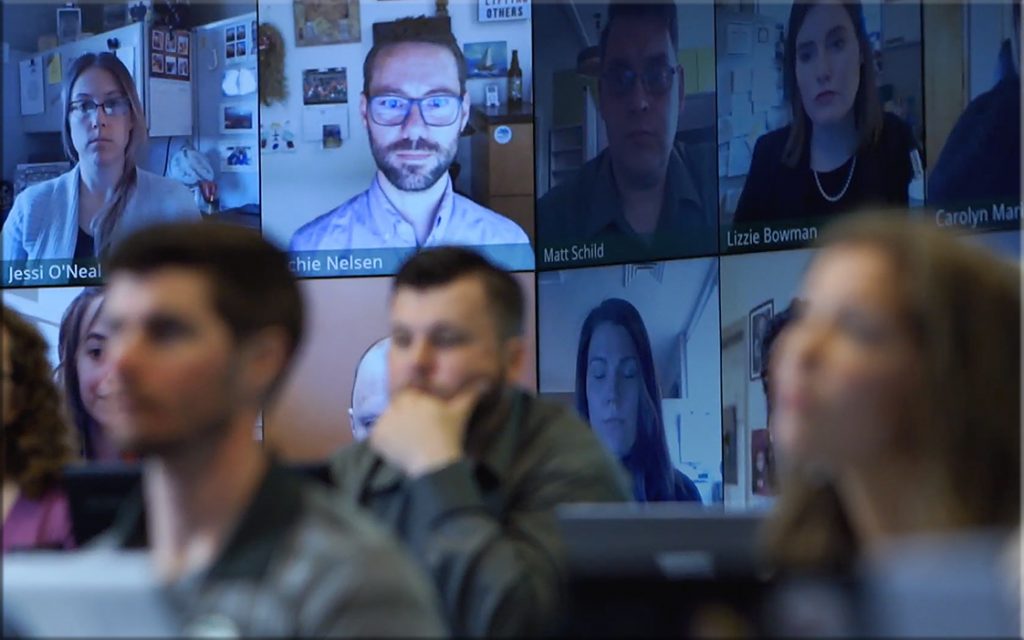

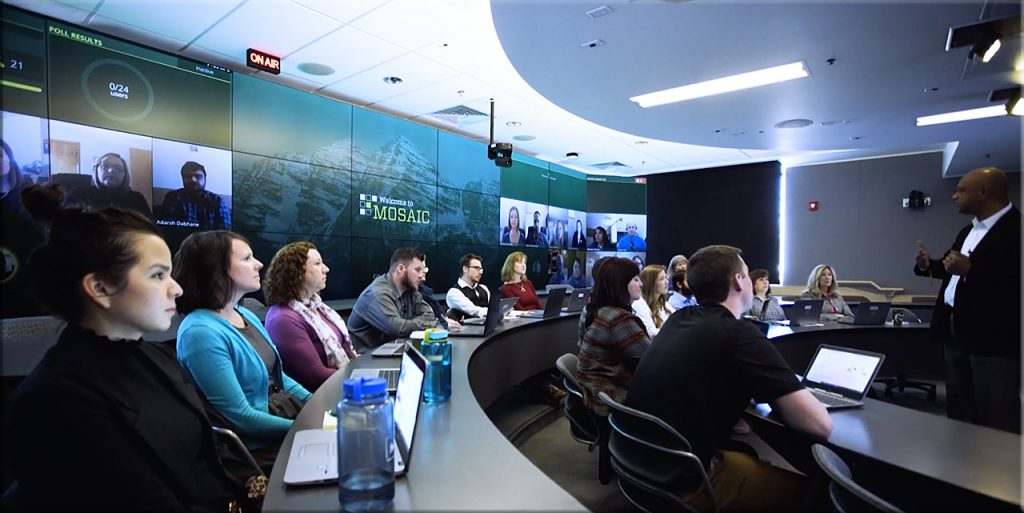
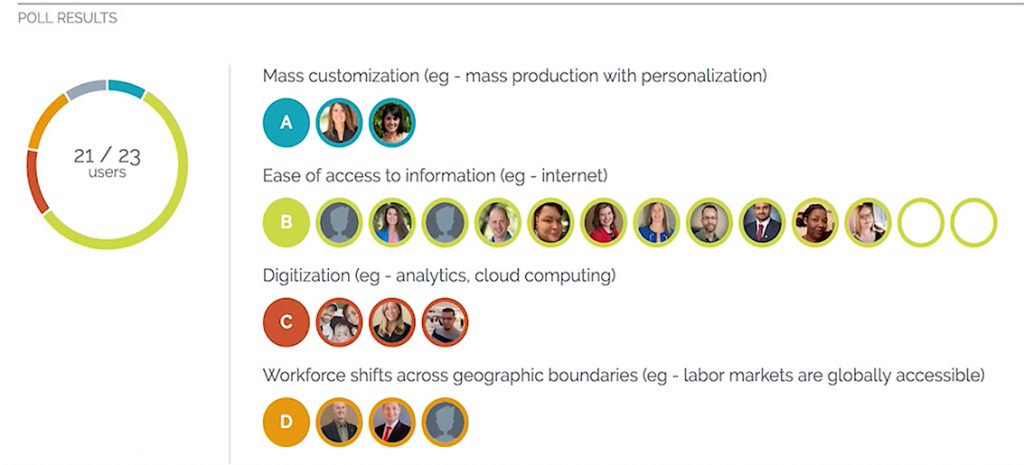

Also see:
Also see:
Collaboration technology is fueling enterprise transformation – increasing agility, driving efficiency and improving productivity. Join Amy Chang at Enterprise Connect where she will share Cisco’s vision for the future of collaboration, the foundations we have in place and the amazing work we’re driving to win our customers’ hearts and minds. Cognitive collaboration – technology that weaves context and intelligence across applications, devices and workflows, connecting people with customers & colleagues, to deliver unprecedented experiences and transform how we work – is at the heart of our efforts. Join this session to see our technology in action and hear how our customers are using our portfolio of products today to transform the way they work.
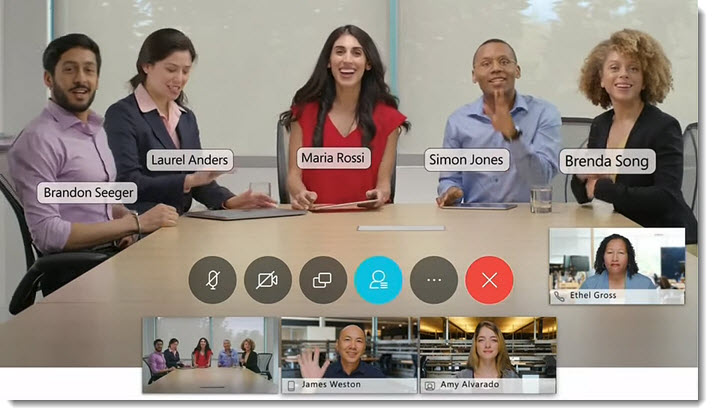
From a fairly recent e-newsletter from edsurge.com — though I don’t recall the exact date (emphasis DSC):
New England is home to some of the most famous universities in the world. But the region has also become ground zero for the demographic shifts that promise to disrupt higher education.
This week saw two developments that fit the narrative. On Monday, Southern Vermont College announced that it would shut its doors, becoming the latest small rural private college to do so. Later that same day, the University of Massachusetts said it would start a new online college aimed at a national audience, noting that it expects campus enrollments to erode as the number of traditional college-age students declines in the coming years.
“Make no mistake—this is an existential threat to entire sectors of higher education,” said UMass president Marty Meehan in announcing the online effort.
The approach seems to parallel the U.S. retail sector, where, as a New York Times piece outlines this week, stores like Target and WalMart have thrived by building online strategies aimed at competing with Amazon, while stores like Gap and Payless, which did little to move online, are closing stores. Of course, college is not like any other product or service, and plenty of campuses are touting the richness of the experience that students get by actually coming to a campus. And it’s not clear how many colleges can grow online to a scale that makes their investments pay off.
“It’s predicted that over the next several years, four to five major national players with strong regional footholds will be established. We intend to be one of them.”
University of Massachusetts President Marty Meehan
From DSC:
That last quote from UMass President Marty Meehan made me reflect upon the idea of having one or more enormous entities that will provide “higher education” in the future. I wonder if things will turn out to be that we’ll have more lifelong learning providers and platforms in the future — with the idea of a 60-year curriculum being an interesting idea that may come into fruition.
Long have I predicted that such an enormous entity would come to pass. Back in 2008, I named it the Forthcoming Walmart of Education. But then as the years went by, I got bumbed out on some things that Walmart was doing, and re-branded it the Forthcoming Amazon.com of Higher Education. We’ll see how long that updated title lasts — but you get the point. In fact, the point aligns very nicely with what futurist Thomas Frey has been predicting for years as well:
“I’ve been predicting that by 2030 the largest company on the internet is going to be an education-based company that we haven’t heard of yet,” Frey, the senior futurist at the DaVinci Institute think tank, tells Business Insider. (source)
I realize that education doesn’t always scale well…but I’m thinking that how people learn in the future may be different than how we did things in the past…communities of practice comes to mind…as does new forms of credentialing…as does cloud-based learner profiles…as does the need for highly efficient, cost-effective, and constant opportunities/means to reinvent oneself.
Also see:
- Fearing ‘existential threat,’ U of Massachusetts unveils plans for national online platform — from educationdive.com by Natalie Schwartz
Addendum:
74% of consumers go to Amazon when they’re ready to buy something. That should be keeping retailers up at night. — from cnbc.com
Key points (emphasis DSC)
- Amazon remains a looming threat for some of the biggest retailers in the country — like Walmart, Target and Macy’s.
- When consumers are ready to buy a specific product, nearly three-quarters of them, or 74 percent, are going straight to Amazon to do it, according to a new study by Feedvisor.
- By the end of this year, Amazon is expected to account for 52.4 percent of the e-commerce market in the U.S., up from 48 percent in 2018.
“In New England, there will be between 32,000 and 54,000 fewer college-aged students just seven years from now,” Meehan said. “That means colleges and universities will have too much capacity and not enough demand at a time when the economic model in higher education is already straining under its own weight.” (Marty Meehan at WBUR)
From DSC:
In a next generation learning system, it would be sharp/beneficial to have a Netflix-like interface to check out potential functionalities that you could turn on and off (at will) — as one component of your learning ecosystem that could feature a setup located in your living room or office.
For example, put a Netflix-like interface to the apps out at eduappcenter.com (i.e., using a rolling interface at first, then going to a static page/listing of apps…again…similar to Netflix).
Amazon has 10,000 employees dedicated to Alexa — here are some of the areas they’re working on — from businessinsider.com by Avery Hartmans
Summary (emphasis DSC):
- Amazon’s vice president of Alexa, Steve Rabuchin, has confirmed that yes, there really are 10,000 Amazon employees working on Alexa and the Echo.
- Those employees are focused on things like machine learning and making Alexa more knowledgeable.
- Some employees are working on giving Alexa a personality, too.
From DSC:
How might this trend impact learning spaces? For example, I am interested in using voice to intuitively “drive” smart classroom control systems:
- “Alexa, turn on the projector”
- “Alexa, dim the lights by 50%”
- “Alexa, open Canvas and launch my Constitutional Law I class”
From DSC:
How long before voice drives most appliances, thermostats, etc?
Hisense is bringing Android and AI smarts to its 2019 TV range — from techradar.com by Stephen Lambrechts
Some big announcements planned for CES 2019
Excerpt (emphasis DSC):
Hisense has announced that it will unveil the next evolution of its VIDAA smart TV platform at CES 2019 next month, promising to take full advantage of artificial intelligence with version 3.0.
Each television in Hisense’s 2019 ULED TV lineup will boast the updated VIDAA 3.0 AI platform, with Amazon Alexa functionality fully integrated into the devices, meaning you won’t need an Echo device to use Alexa voice control features.
The information below is from Heather Campbell at Chegg
(emphasis DSC)
Chegg Math Solver is an AI-driven tool to help the student understand math. It is more than just a calculator – it explains the approach to solving the problem. So, students won’t just copy the answer but understand and can solve similar problems at the same time. Most importantly,students can dig deeper into a problem and see why it’s solved that way. Chegg Math Solver.
In every subject, there are many key concepts and terms that are crucial for students to know and understand. Often it can be hard to determine what the most important concepts and terms are for a given subject, and even once you’ve identified them you still need to understand what they mean. To help you learn and understand these terms and concepts, we’ve provided thousands of definitions, written and compiled by Chegg experts. Chegg Definition.
From DSC:
I see this type of functionality as a piece of a next generation learning platform — a piece of the Living from the Living [Class] Room type of vision. Great work here by Chegg!
Likely, students will also be able to take pictures of their homework, submit it online, and have that image/problem analyzed for correctness and/or where things went wrong with it.
Top Trends in Active and Collaborative Learning — from thesextantgroup.com by Joe Hammett
Excerpts:
My daughter is a maker. She spends hours tinkering with sewing machines and slime recipes, building salamander habitats and the like. She hangs out with her school friends inside apps that teach math and problem solving through multi-player games. All the while, they are learning to communicate and collaborate in ways that are completely foreign to their grandparent’s generation. She is 10 years old and represents a shift in human cognitive processing brought about by the mastery of technology from a very young age. Her generation and those that come after have never known a time without technology. Personal devices have changed the shared human experience and there is no turning back.
The spaces in which this new human chooses to occupy must cater to their style of existence. They see every display as interactive and are growing up knowing that the entirety of human knowledge is available to them by simply asking Alexa. The 3D printer is a familiar concept and space travel for pleasure will be the norm when they have children of their own.
Current trends in active and collaborative learning are evolving alongside these young minds and when appropriately implemented, enable experiential learning and creative encounters that are changing the very nature of the learning process. Attention to the spaces that will support the educators is also paramount to this success. Lesson plans and teaching style must flip with the classroom. The learning space is just a room without the educator and their content.
…
8. Flexible and Reconfigurable
With floor space at a premium, classrooms need to be able to adapt to a multitude of uses and pedagogies. Flexible furniture will allow the individual instructor freedom to set up the space as needed for their intended activities without impacting the next person to use the room. Construction material choices are key to achieving an easily reconfigurable space. Raised floors and individually controllable lighting fixtures allow a room to go from lecture to group work with ease. Whiteboard paints and rail mounting systems make walls reconfigurable too!.
Active Learning, Flipped Classroom, SCALE-UP, TEAL Classroom, whatever label you choose to place before it, the classroom, learning spaces of all sorts, are changing. The occupants of these spaces demand that they are able to effectively, and comfortably, share ideas and collaborate on projects with their counterparts both in person and in the ether. A global shift is happening in the way humans share ideas. Disruptive technology, on a level not seen since the assembly line, is driving a change in the way humans interact with other humans. The future is collaborative.
Are ‘smart’ classrooms the future? — from campustechnology.com by Julie Johnston
Indiana University explores that question by bringing together tech partners and university leaders to share ideas on how to design classrooms that make better use of faculty and student time.
Excerpt:
To achieve these goals, we are investigating smart solutions that will:
- Untether instructors from the room’s podium, allowing them control from anywhere in the room;
- Streamline the start of class, including biometric login to the room’s technology, behind-the-scenes routing of course content to room displays, control of lights and automatic attendance taking;
- Offer whiteboards that can be captured, routed to different displays in the room and saved for future viewing and editing;
- Provide small-group collaboration displays and the ability to easily route content to and from these displays; and
- Deliver these features through a simple, user-friendly and reliable room/technology interface.
…
Activities included collaborative brainstorming focusing on these questions:
- What else can we do to create the classroom of the future?
- What current technology exists to solve these problems?
- What could be developed that doesn’t yet exist?
- What’s next?
From DSC:
Though many peoples’ — including faculty members’ — eyes gloss over when we start talking about learning spaces and smart classrooms, it’s still an important topic. Personally, I’d rather be learning in an engaging, exciting learning environment that’s outfitted with a variety of tools (physically as well as digitally and virtually-based) that make sense for that community of learners. Also, faculty members have very limited time to get across campus and into the classroom and get things setup…the more things that can be automated in those setup situations the better!
I’ve long posted items re: machine-to-machine communications, voice recognition/voice-enabled interfaces, artificial intelligence, bots, algorithms, a variety of vendors and their products including Amazon’s Alexa / Apple’s Siri / Microsoft’s Cortana / and Google’s Home or Google Assistant, learning spaces, and smart classrooms, as I do think those things are components of our future learning ecosystems.
To higher ed: When the race track is going 180mph, you can’t walk or jog onto the track. [Christian]
From DSC:
When the race track is going 180mph, you can’t walk or jog onto the track. What do I mean by that?
Consider this quote from an article that Jeanne Meister wrote out at Forbes entitled, “The Future of Work: Three New HR Roles in the Age of Artificial Intelligence:”*
This emphasis on learning new skills in the age of AI is reinforced by the most recent report on the future of work from McKinsey which suggests that as many as 375 million workers around the world may need to switch occupational categories and learn new skills because approximately 60% of jobs will have least one-third of their work activities able to be automated.
Go scan the job openings and you will likely see many that have to do with technology, and increasingly, with emerging technologies such as artificial intelligence, deep learning, machine learning, virtual reality, augmented reality, mixed reality, big data, cloud-based services, robotics, automation, bots, algorithm development, blockchain, and more.
From Robert Half’s 2019 Technology Salary Guide
How many of us have those kinds of skills? Did we get that training in the community colleges, colleges, and universities that we went to? Highly unlikely — even if you graduated from one of those institutions only 5-10 years ago. And many of those institutions are often moving at the pace of a nice leisurely walk, with some moving at a jog, even fewer are sprinting. But all of them are now being asked to enter a race track that’s moving at 180mph. Higher ed — and society at large — are not used to moving at this pace.
This is why I think that higher education and its regional accrediting organizations are going to either need to up their game hugely — and go through a paradigm shift in the required thinking/programming/curricula/level of responsiveness — or watch while alternatives to institutions of traditional higher education increasingly attract their learners away from them.
This is also, why I think we’ll see an online-based, next generation learning platform take place. It will be much more nimble — able to offer up-to-the minute, in-demand skills and competencies.
The below graphic is from:
Jobs lost, jobs gained: What the future of work will mean for jobs, skills, and wages
* Three New HR Roles To Create Compelling Employee Experiences
These new HR roles include:
- IBM: Vice President, Data, AI & Offering Strategy, HR
- Kraft Heinz Senior Vice President Global HR, Performance and IT
- SunTrust Senior Vice President Employee Wellbeing & Benefits
What do these three roles have in common? All have been created in the last three years and acknowledge the growing importance of a company’s commitment to create a compelling employee experience by using data, research, and predictive analytics to better serve the needs of employees. In each case, the employee assuming the new role also brought a new set of skills and capabilities into HR. And importantly, the new roles created in HR address a common vision: create a compelling employee experience that mirrors a company’s customer experience.
An excerpt from McKinsey Global Institute | Notes from the Frontier | Modeling the Impact of AI on the World Economy
Workers.
A widening gap may also unfold at the level of individual workers. Demand for jobs could shift away from repetitive tasks toward those that are socially and cognitively driven and others that involve activities that are hard to automate and require more digital skills.12 Job profiles characterized by repetitive tasks and activities that require low digital skills may experience the largest decline as a share of total employment, from some 40 percent to near 30 percent by 2030. The largest gain in share may be in nonrepetitive activities and those that require high digital skills, rising from some 40 percent to more than 50 percent. These shifts in employment would have an impact on wages. We simulate that around 13 percent of the total wage bill could shift to categories requiring nonrepetitive and high digital skills, where incomes could rise, while workers in the repetitive and low digital skills categories may potentially experience stagnation or even a cut in their wages. The share of the total wage bill of the latter group could decline from 33 to 20 percent.13 Direct consequences of this widening gap in employment and wages would be an intensifying war for people, particularly those skilled in developing and utilizing AI tools, and structural excess supply for a still relatively high portion of people lacking the digital and cognitive skills necessary to work with machines.









